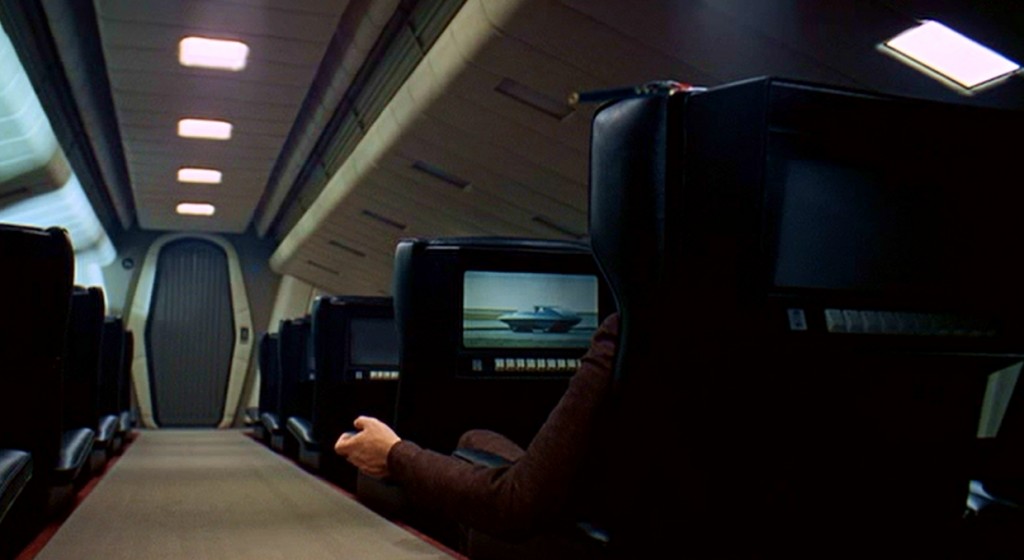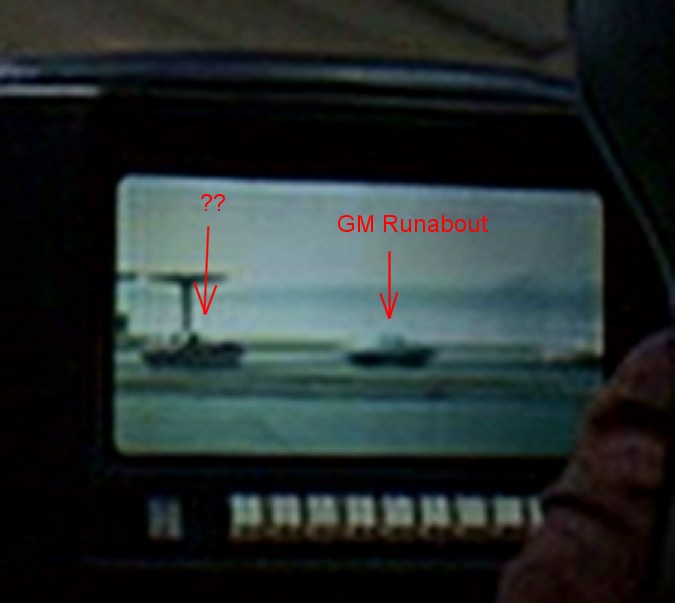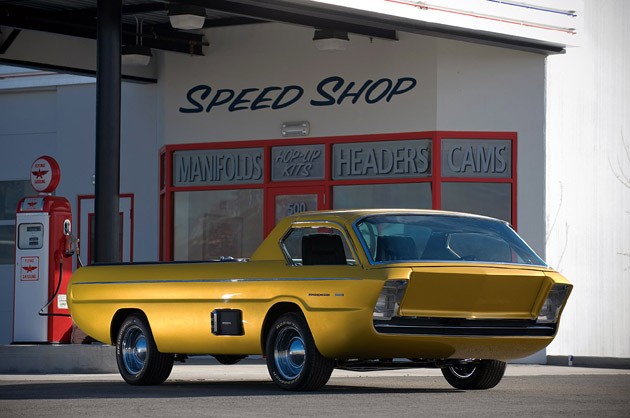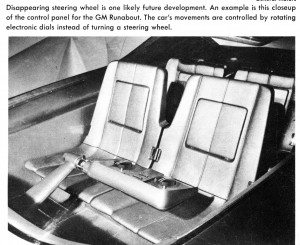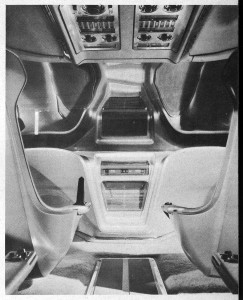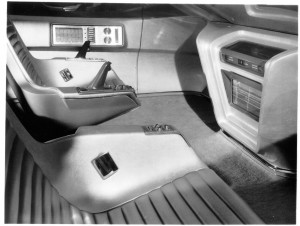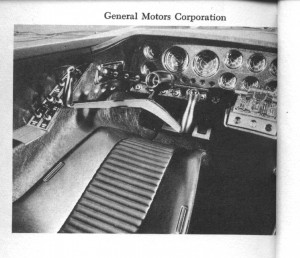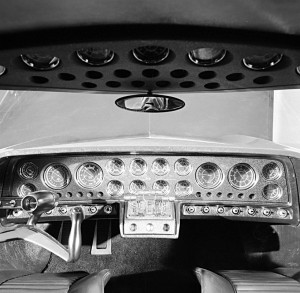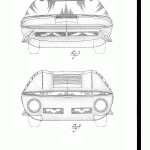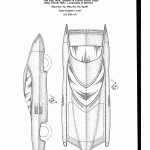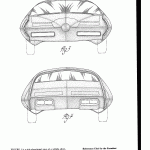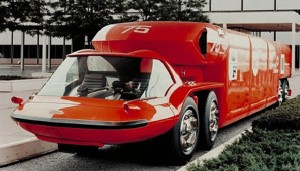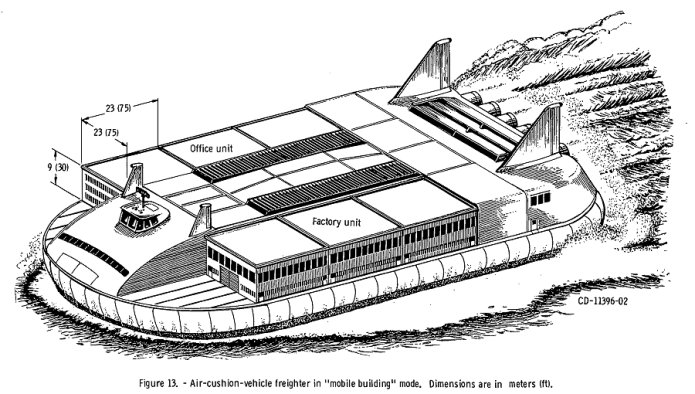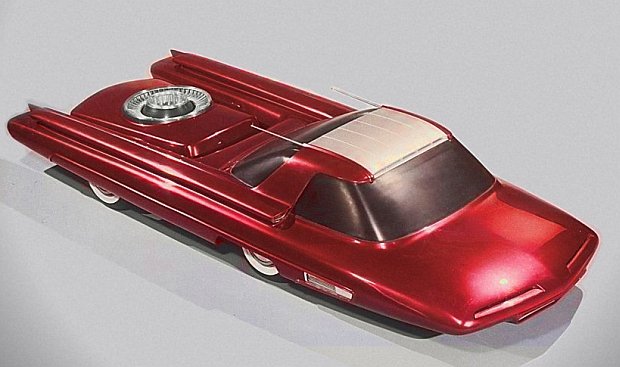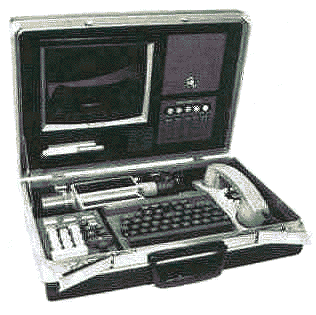Here’s a minor one: the automobiles of 2001.
The books and movies related to “2001: A Space Odyssey” provide little to no information about the automobiles in use around the year 2001 of the alternate timeline. To my knowledge, “2001:ASO” the movie showed a grand total of two cars; “2010” showed one (and a bicycle).
In “2001:ASO” there is a very brief, poorly displayed scene playing out on the back of a passenger seat on the Orion III spaceplane. This is a bit of “in flight entertainment,” either a TV show or a movie. The scene was shot specifically for “2001” in Detroit. In the scene, you can make out two vehicles; one is far too low-rez to make out. The other is a General Motors “Runabout” concept car from 1964. The “Runabout” was a small vehicle, basically basic transportation meant for urban dwellers going to the store, picking up kids from school, that sort of thing. It wasn’t meant to go fast, go far or carry much. In many ways, it did look not unlike the economy cars of the 1970’s and beyond… AMC Pacer and such. However, there were a few important differences: the body was more “stylized” than the econoboxes that came later. There’s no rear fender, for example… something that would probably be in violation of some regulation somewhere. The windshield wrapped around most of the top of the car. It’s pointier and more wedge-like than the later cars. And most of all, it only had three wheels: two in the back, one in front. Such cars have been built from time to time, and achieved at least some level of popularity in post-war Britain, but never caught on in the US.
The “Runabout” was one of those concept cars that the US automotive industry cranked out seemingly by the truckload until the 1970s energy crisis drained the joy out of car design.
Here’s the scene:
That’s pretty clearly the “Runabout.” Some descriptions say that the vehicle was modified for “2001,” but if so, the modifications don’t seem terribly obvious. The only thing that looks like it might be different is the front wheel… on the small screen, it *kinda* looks like it might have been mocked up to look like a four-wheeler. But it’s hard to say. Here’s the Runabout in all its PR glory:
As for the other vehicle, this seems to be as good as it gets:
Really hard to make out, but I think it’s a truck. The cab is very far forward, and the bed seems pretty long… might it be the Dodge Deora? The Deora was unveiled in Detroit in 1967, so… maybe.
It could also be that I’m looking at the mystery vehicle *backwards,* and the “cab” is actually far at the back, meaning a very long “nose.” In that case, this would very likely be a “dream” sports car. Just too fuzzy to tell.
If the mystery vehicle is the Deora, it shares with the Runabout something important: while neither are really close matches for the kind of vehicles actually sold in the real world of 1999-2001, they also represent a major shift in thinking in concept cars from just a few years earlier. Just slightly before the Runabout, concept cars tended to look like ridiculous 1950’s sci-fi movie space ships: big fins and nozzles and sharp spiky bits, perfect for impaling or disemboweling pedestrians, but not much else. The Runabout and the Deora demonstrate restraint comparatively. While still being pretty futuristic, at least as seen from 1968.
The Runabout had stablemates. If it’s safe to say that in the alternate history a concept car from 1964 would be a production car in 1999, then the concept cars that came out with the Runabout might be equally valid. At the 1964 Worlds Fair (a concept that was pretty well extinct by 2001), GM showed off not only the Runabout, but the Firebird IV and GM-X (AKA “Stiletto”) concepts. The Runabout and the Firebird IV were clearly designed by the same people, using similar lines.
If the Runabout is 2001:ASO canon (and it is), then it seems reasonably safe to assume that the Firebird IV can also be wedged in there, and perhaps also the GM-X/Stiletto.Interestingly, the Firebird IV was listed as being meant for automated highways; at the time, it seemed reasonable to assume that cars would be self-driving before too long. Whether GM thought the car would be autonomously self-controlled by onboard computers, or externally piloted by a large HAL-9000-like mainframe I can’t say… but I can bet that the HAL option would be the logical one given the state of electronics in “2001.”
As for controlling the Runabout… who needs pesky steering wheels when you have a gigantic Nintendo controller?
Since the Firebird IV is computer controlled, it hardly needs a drive. And not needing a driver means you can dispense with things like controls. Because that worked out so well on the XD-1.
And this here is the *fully* terrifying interior of the GM-X, a true Mans Car with not of that “computer controlled” gibberish. Airbags? Pfff. Don’t need them, son. But you know what we do need? Instruments. Lots of ’em. Above, below, off to the side…
For those of you model fanatics who want to have models of everything in 2001, you’re in luck… GM got patents on each of these designs, so there are drawings available. Also available is a list of dimensions for the three vehicles, certainly handy for scale modelers.
The list of data would seem to come from something describing the displays at the 1964 Worlds Fair. The last item on the list – with the data presumably on the following un-available page, is the GM “Bison,” which was certainly a unique looking truck:
The Bison was turbine powered. The ‘module’ above the cab contained turboshaft engines, which powered the wheels below. It was meant to be very low profile, and to be part of a standardized shipping system, with standard containers organized by computer. Hmm. Very “2001.” While, to my knowledge, there is zero evidence not only for the Bison in the “2001” canon, and not even a mention of a truck… there would certainly be trucks trundling around hauling cargo, and this looks like it’d fit the bill.
